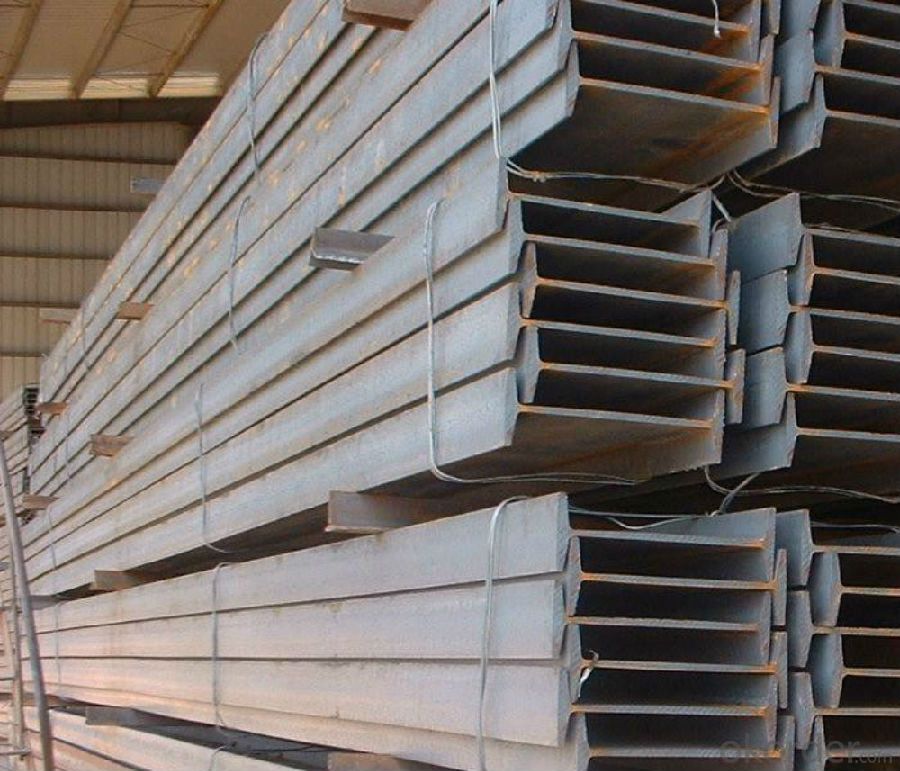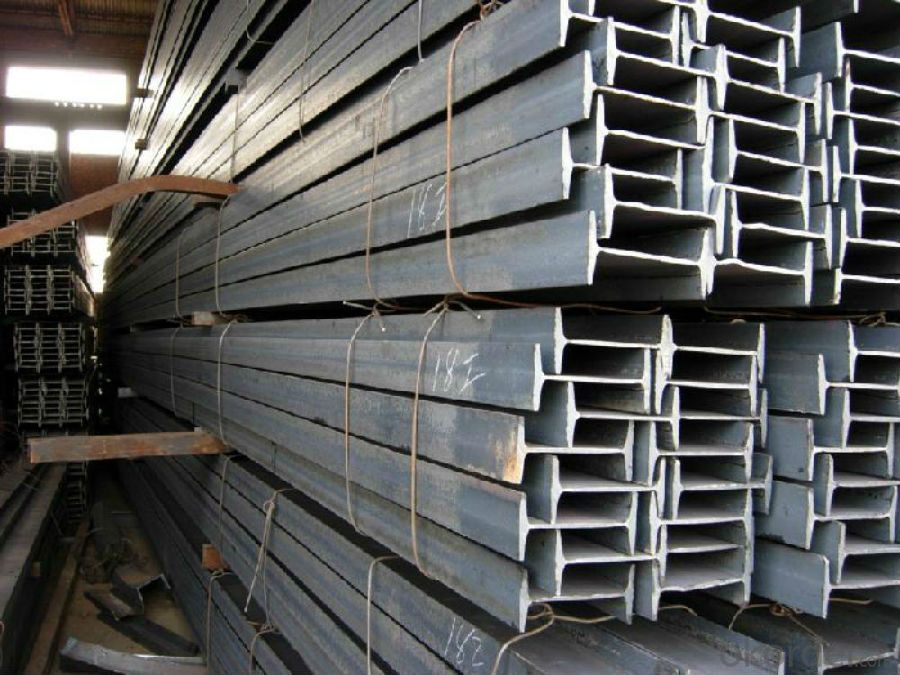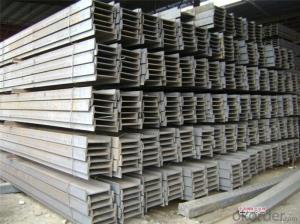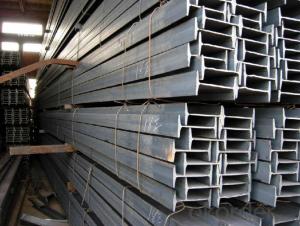Hot Rolled IPE and IPEAA Beam with Q235B Grade
- Loading Port:
- Tianjin
- Payment Terms:
- TT OR LC
- Min Order Qty:
- 25 m.t.
- Supply Capability:
- 10000 m.t./month
OKorder Service Pledge
OKorder Financial Service
You Might Also Like
Product Description:
OKorder is offering high quality Hot Rolled Steel I-Beams at great prices with worldwide shipping. Our supplier is a world-class manufacturer of steel, with our products utilized the world over. OKorder annually supplies products to European, North American and Asian markets. We provide quotations within 24 hours of receiving an inquiry and guarantee competitive prices.
Product Applications:
Hot Rolled Steel I-Beams are ideal for structural applications and are widely used in the construction of buildings and bridges, and the manufacturing, petrochemical, and transportation industries.
Product Advantages:
OKorder's Steel I-Beams are durable, strong, and resist corrosion.
Main Product Features:
· Premium quality
· Prompt delivery & seaworthy packing (30 days after receiving deposit)
· Corrosion resistance
· Can be recycled and reused
· Mill test certification
· Professional Service
· Competitive pricing
Product Specifications:
Manufacture: Hot rolled
Grade: Q195 – 235
Certificates: ISO, SGS, BV, CIQ
Length: 6m – 12m, as per customer request
Packaging: Export packing, nude packing, bundled
Chinese Standard (H*W*T) | Weight (Kg/m) | 6m (pcs/ton) | Light I (H*W*T) | Weight (Kg/m) | 6m (pcs/ton) | Light II (H*W*T) | Weight (Kg/m) | 6M |
100*68*4.5 | 11.261 | 14.8 | 100*66*4.3 | 10.13 | 16.4 | 100*64*4 | 8.45 | 19.7 |
120*74*5.0 | 13.987 | 11.9 | 120*72*4.8 | 12.59 | 13.2 | 120*70*4.5 | 10.49 | 15.8 |
140*80*5.5 | 16.89 | 9.8 | 140*78*5.3 | 15.2 | 10.9 | 140*76*5 | 12.67 | 13.1 |
160*88*6 | 20.513 | 8.1 | 160*86*5.8 | 18.46 | 9 | 160*84*5.5 | 15.38 | 10.8 |
180*94*6.5 | 24.143 | 6.9 | 180*92*6.3 | 21.73 | 7.6 | 180*90*6 | 18.11 | 9.2 |
200*100*7 | 27.929 | 5.9 | 200*98*6.8 | 25.14 | 6.6 | 200*96*6.5 | 20.95 | 7.9 |
220*110*7.5 | 33.07 | 5 | 220*108*7.3 | 29.76 | 5.6 | 220*106*7 | 24.8 | 6.7 |
250*116*8 | 38.105 | 4.3 | 250*114*7.8 | 34.29 | 4.8 | 250*112*7.5 | 28.58 | 5.8 |
280*122*8.5 | 43.492 | 3.8 | 280*120*8.2 | 39.14 | 4.2 | 280*120*8 | 36.97 | 4.5 |
300*126*9 | 48.084 | 3.4 | 300*124*9.2 | 43.28 | 3.8 | 300*124*8.5 | 40.87 | 4 |
320*130*9.5 | 52.717 | 3.1 | 320*127*9.2 | 48.5 | 3.4 | |||
360*136*10 | 60.037 | 2.7 | 360*132*9.5 | 55.23 | 3 |
FAQ:
Q1: Why buy Materials & Equipment from OKorder.com?
A1: All products offered byOKorder.com are carefully selected from China's most reliable manufacturing enterprises. Through its ISO certifications, OKorder.com adheres to the highest standards and a commitment to supply chain safety and customer satisfaction.
Q2: What makes stainless steel stainless?
A2: Stainless steel must contain at least 10.5 % chromium. It is this element that reacts with the oxygen in the air to form a complex chrome-oxide surface layer that is invisible but strong enough to prevent further oxygen from "staining" (rusting) the surface. Higher levels of chromium and the addition of other alloying elements such as nickel and molybdenum enhance this surface layer and improve the corrosion resistance of the stainless material.
Q3: Can stainless steel rust?
A3: Stainless does not "rust" as you think of regular steel rusting with a red oxide on the surface that flakes off. If you see red rust it is probably due to some iron particles that have contaminated the surface of the stainless steel and it is these iron particles that are rusting. Look at the source of the rusting and see if you can remove it from the surface.
Images:



- Q:What is the theoretical weight per metric ton of 30# I-beam?
- 30#a hot rolled I-beam 48.084kg/m, 30#b hot rolled I-beam 52.794kg/m.It is possible to use H steel instead of hot rolled i-beam. H steel is easy to process, more flexible in specifications and free from the standard type of hot-rolled i-beam. HM 300*200*8*12, 57.3kg/m weight meter.
- Q:How are steel I-beams protected against impact damage?
- Steel I-beams are commonly used in construction projects due to their high strength and load-bearing capabilities. However, they are susceptible to impact damage, which can compromise their structural integrity. To protect steel I-beams against impact damage, several measures can be taken. 1. Protective Coatings: Applying protective coatings to the surface of steel I-beams is a common method to safeguard against impact damage. These coatings, such as epoxy or polyurethane, create a barrier that absorbs and disperses the impact energy, reducing the likelihood of damage. 2. Impact-Resistant Cladding: Another approach is to add impact-resistant cladding to the steel I-beams. This can be achieved through the use of materials like rubber or composite panels that act as a buffer against impact forces. The cladding absorbs the energy and dissipates it, shielding the I-beams from damage. 3. Bumpers and Cushions: In high-traffic areas or where there is a risk of frequent impacts, installing bumpers or cushions can help protect the steel I-beams. These are typically made of rubber or other resilient materials and act as shock absorbers, minimizing the force transferred to the I-beams. 4. Reinforcement Techniques: Strengthening the steel I-beams through reinforcement techniques can also enhance their resistance to impact damage. This may involve adding additional steel plates or beams to critical areas, effectively distributing the impact forces and preventing localized damage. 5. Structural Design Considerations: Lastly, the structural design of the steel I-beams can be optimized to minimize the risk of impact damage. This includes selecting appropriate beam sizes, spacing, and connections, as well as considering the expected loads and potential impact scenarios during the design phase. Implementing these protective measures can significantly reduce the likelihood and severity of impact damage to steel I-beams, ensuring their long-term structural integrity and safety.
- Q:Can steel I-beams be used in seismic retrofitting projects?
- Yes, steel I-beams can be used in seismic retrofitting projects. In fact, they are often a preferred choice due to their high strength and stiffness properties. Steel I-beams can be used to reinforce existing structures, such as buildings, bridges, and other infrastructure, to enhance their resistance to seismic forces. These beams are typically installed strategically in areas that require additional support, such as at key load-bearing points or along vulnerable sections of the structure. By adding steel I-beams, the overall structural integrity and stability of the building or infrastructure can be significantly improved, reducing the risk of damage or collapse during an earthquake. Additionally, steel I-beams can also be used in conjunction with other retrofitting techniques, such as bracing systems or base isolation, to further enhance the seismic performance of a structure.
- Q:How do steel I-beams perform in terms of energy consumption?
- When it comes to energy consumption, steel I-beams are incredibly efficient. They boast a remarkable strength-to-weight ratio, enabling them to bear substantial weights with minimal steel usage. Consequently, the manufacturing and transportation processes demand less energy due to reduced raw material and fuel requirements. Moreover, steel I-beams exhibit exceptional durability and longevity, minimizing the need for frequent maintenance or replacements. As a result, energy consumption is further reduced by eliminating the necessity for frequent repairs or replacements. All in all, steel I-beams prove to be a wise energy-efficient option for structural purposes.
- Q:Can steel I-beams be used for historical building restoration?
- Historical building restoration can indeed utilize steel I-beams. In fact, these beams are often the preferred choice for reinforcing and stabilizing historical structures. They offer substantial structural support while minimizing any negative effects on the building's original architecture and aesthetic. Aging, deterioration, and insufficient initial construction frequently lead to structural problems in historical buildings. By incorporating steel I-beams, compromised sections can be strengthened and stabilized, ensuring the building's longevity and safety. This is especially critical in areas prone to seismic activity or heavy loads. The strength and versatility of steel I-beams are their primary advantages. They can be tailor-made to meet the specific requirements of each restoration project, providing precise support in crucial areas. Additionally, these beams are lightweight and easy to transport and install, minimizing disruption during the restoration process. Furthermore, steel I-beams can be discreetly incorporated into the original structure, preserving the building's historical integrity. This is essential for maintaining architectural authenticity and adhering to historical preservation guidelines. However, it is crucial to consult with structural engineers, architects, and preservation specialists before deciding to use steel I-beams for historical building restoration. These professionals will carefully evaluate the building's structural needs and develop a restoration plan that acknowledges its historical significance while incorporating the necessary reinforcements. In conclusion, steel I-beams are a viable choice for historical building restoration. They offer the required strength and support while minimizing any negative impact on the building's historical fabric. With proper planning and expertise, steel I-beams can be successfully integrated into the restoration process, ensuring the preservation of historical buildings for future generations.
- Q:What are the load-bearing capacities of steel I-beams?
- The load-bearing capacities of steel I-beams can vary depending on their size, shape, and material grade. However, on average, steel I-beams can typically support significant loads ranging from a few thousand pounds to several hundred thousand pounds. It is essential to consult engineering tables or professionals to determine the specific load-bearing capacity of a particular steel I-beam.
- Q:What are the different methods of maintaining steel I-beams over time?
- There are several methods of maintaining steel I-beams over time, including regular cleaning and inspection, applying protective coatings or paints, addressing corrosion issues promptly, and conducting structural assessments to identify any potential weaknesses. Additionally, implementing preventive measures like proper drainage systems and avoiding excessive loads can help prolong the lifespan of steel I-beams.
- Q:What are the meanings of I-beam BH300 x 200 x 6 x 8 in steel structures?
- I-beam is also called steel girder (English name Universal Beam). It is a strip of steel with an I-shaped section. I-beam is made of ordinary I-beam and light i-beam. It is a section steel whose shape is trough.
- Q:Will the raw material of I-beam and channel steel be re examined?
- A formal manufacturer may require a warranty and should not be required. Irregular manufacturers, then they need to test their own or commissioned the test.
- Q:Can steel I-beams be used for curtain wall systems?
- Indeed, curtain wall systems can make use of steel I-beams. In commercial buildings, these systems are usually employed to offer an external façade and bear the weight of the structure. Steel I-beams are a popular choice for curtain wall systems due to their exceptional load-bearing capacities and ability to withstand the forces exerted on the building. They provide structural support and can be tailored to accommodate the weight of curtain wall panels, glass, and other elements. Furthermore, steel I-beams possess durability and resilience against various weather conditions, rendering them appropriate for application in curtain wall systems.
1. Manufacturer Overview |
|
|---|---|
| Location | |
| Year Established | |
| Annual Output Value | |
| Main Markets | |
| Company Certifications | |
2. Manufacturer Certificates |
|
|---|---|
| a) Certification Name | |
| Range | |
| Reference | |
| Validity Period | |
3. Manufacturer Capability |
|
|---|---|
| a)Trade Capacity | |
| Nearest Port | |
| Export Percentage | |
| No.of Employees in Trade Department | |
| Language Spoken: | |
| b)Factory Information | |
| Factory Size: | |
| No. of Production Lines | |
| Contract Manufacturing | |
| Product Price Range | |
Send your message to us
Hot Rolled IPE and IPEAA Beam with Q235B Grade
- Loading Port:
- Tianjin
- Payment Terms:
- TT OR LC
- Min Order Qty:
- 25 m.t.
- Supply Capability:
- 10000 m.t./month
OKorder Service Pledge
OKorder Financial Service
Similar products
New products
Hot products
Hot Searches
Related keywords





























